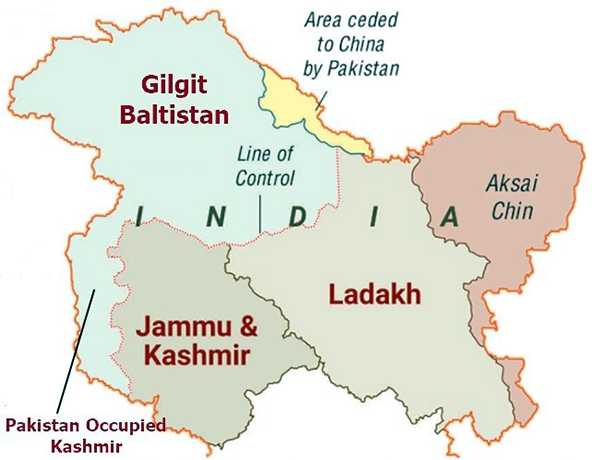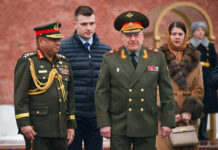
Defence Minister Rajnath Singh, on 27 October, said that India had “only just begun walking north,” and the journey would end when “we…reach the remaining parts (of PoK), Gilgit and Baltistan.” This, he said, would “implement the resolution passed unanimously by India’s Parliament on February 22, 1994”.
The 1994 parliamentary resolution which Rajnath Singh referred to read, “On behalf of the people of India we firmly declare that the state of Jammu & Kashmir has been, is and shall be an integral part of India and any attempts to separate it from the rest of the country will be resisted by all necessary means…. India has the will and capacity to firmly counter all designs against its unity, sovereignty and territorial integrity and demands that Pakistan must vacate the areas of the Indian state of Jammu & Kashmir, which they have occupied through aggression and resolves that all attempts to interfere with the internal affairs of India will be met resolutely.’
Many would describe this as adventurism of the kind Russia has engaged in to capture areas in Ukraine.
Gilgit-Baltistan is right in the north of the Ladakh part of united Jammu & Kashmir. The Corps Commander of 15 Corps in Srinagar was asked to react to what the defence minister said. He said if orders came to march North, all forces are ready. We are refining our forces’ conventional capabilities. When it is required there should be no looking back.
This was not the first time when India had said that in its efforts to push towards Akhand Bharat “We will reclaim Pakistan Occupied Kashmir (POK).” As recently as in September 2019 the foreign minister said, “POK is part of India and we expect one day that we will have physical jurisdiction over.” Removal of Article 370 and 35A of the Indian Constitution has sent an unambiguous signal that J&K is not negotiable and all that has to be settled is PoK and Baltistan, he added.
All this is happening when Pakistan looks extremely feeble with a round of political infighting.
Sometimes politicians need to make statements which will boost the morale of the country but this was not something that was happening in isolation over the last few days or years, rather the prime minister and his ministers’ statements have been coming out with quite regularity.
Strategic Opportunity
If you go by a geostrategic precedent. In 1962 – Russia and the United States were teetering on the brink of a nuclear war.
If India were to choose a geostrategic window for carrying out this operation, it could not have had anything better.
When Shahbaz Sharif took charge in Pakistan, we had a segment in the Indian establishment that felt that he was Nawaz Sharif’s brother. India thought there was a window to improve relations with Pakistan and had reached out to Nawaz Sharif. He had reciprocated very well before Gen Musharraf torpedoed that peace initiative. But on the ground, Pakistan’s military establishment and ISI complex – the Deep State – calls the shots. It matters very little who is the political face in Islamabad. It is just a democratic facade.
The Pakistan Army and ISI have been making a concerted effort to revive the terrorist movements both in J&K and Punjab. This is not a friendly act. India agreed to a ceasefire when they needed it most, when they were trying to take over Afghanistan. It was, perhaps, geostrategically rather short-sighted.
India has given Pakistan full opportunity to show if they would be interested in peace. Their economy is collapsing, the ethnic fault lines are most exacerbated and the political turmoil does not make it wise for Pakistan to have India on the wrong side.
Does India Have the Capacity?
If India were to execute the march north to Gilgit-Baltistan, the armed forces would realise that mountains eat up troops. The Indian Army is already stretched with its deployment in Northern Command on the LAC versus China. on the LOC and the AGPL. Huge number of troops are deployed but they are stretched to control the area in their possession.
Military operations of attack require the forces to have at least a 3-to-1 superiority with a lot of fire power to be able to capture an objective like a hill or a dominating ground the ration goes up. If a battalion is holding a feature, then a brigade level attack goes in, if a brigade is holding it, then at least a division is required. In the case of mountains even higher troop levels are required.
The idea to capture Skardu-Gilgit was first mooted by Gen Sunderji as the Army chief while planning exercise Brasstacks. Ravi Rikhi in his book “1984 The Fourth Round”, suggested that operational model but it never happened for a variety of political reasons.
Pakistan may be in political turmoil but the Army is still capable of holding its own in a defensive scenario. That territory is a conjunction between China’s steady in roads into the Northern Areas where the Chinese have invested at least $26 billion in four or five dams. They are going to invest more because water is part of China’s strategy for global dominance.
At the time of the Kargil War, prime minister Vajpayee in his wisdom did not allow the armed forces to cross Line of Control. Gen Musharraf went in to Kargil to divide the sanctity of the LoC. With these actions, the LoC got sanctified. World opinion will go against India if we cross the LoC at a time when prime minister Modi himself has maintained that this is not the era of wars. He said so about Chinese expansionism and he told Putin publicly on his actions in Ukraine.
Wars cost money and basic calculation is about Rs 5,000 crores upwards every week. Military operations are not only expensive, they have the knack of escalating out of control, no matter what the results of war gaming say. This operation is not going to finish in three days. Gen Sunderji told prime minister Rajiv Gandhi that Indian forces could finish off Sri Lanka’s problems in three days but the armed forces got stuck there for almost two years.
Echoing the views of the defence minister is fine, but the Corps Commanders, the Northern Army Commander and the Army Chief should privately and professionally caution the political leadership that rhetoric apart, a situation like 1962 must be avoided until the forces are fully prepared.
The Folly of War
The Pakistani Army have a tight grip over the entire POK and Northern Areas. There is no real political freedom in either of the two regions and the military establishment calls the shots. Although liberation of Kashmir is a misnomer, Pakistanis are made to believe that they will fight for Kashmiris and their ‘freedom’.
If the Indian armed forces are to carry out any operations in Pok or in Gilgit-Baltistan, it would be a declaration of war. It will not be a Limited War but an all-out war under a nuclear overhang. We cannot adopt a cavalier approach.
With the kind of involvement and involvement the Chinese have made in Pakistan, it will effectively mean a very active two-front situation. No general in any army ever wants to fight on two fronts simultaneously. A two-front war can only be a defensive one.
The defence minister has, perhaps, rattled the cage, not so much because of some domestic political dividend but to put the Pakistanis on the defensive. In the past the Pakistanis kept talking about and threatening to wrest Kashmir from India. India was always seen to be on the defensive.
It will put the Pakistanis on the backfoot and rattle them into thinking that India might do something like that However, seen in the larger context, the defence minister statement was incongruent to what the prime minister Modi told the Russian president that “this is not an era of war.”
India should not fight a war, which it has not won already. In the 1971 War, India had already won the world when it started fighting. It is also important to enhance comprehensive National Power before engaging in any aggressive action.
India is rising but it has a multitude of problems. While there is no need to keep quiet and show that we have the prowess, and put the enemy on the defensive, it is quite another to start exercising that voice. It must be considered that the enemy’s economy will sink but what happens to your own economy at time must also be considered.
Initiating war under a nuclear environment, with a two-front situation, when the when the world is in a flux would be a folly, which is best avoided.
Voids Must Be Made Up
In the last two years of Covid pandemic, India armed forces stopped all recruitment. Sixty thousand men go out every year on pension. We are about 1,50,000 to 2,00,000 lakh troops short in the Indian army right now. Recruitment of Agniveers has opened up. The first step that is required is to speed up getting manpower, otherwise like Russia, we would start the conflict and then start mobilizing. In India, we have a major manpower versus equipment debate. Russia is not short of weapons but because of shortage of manpower they have been hit hard. There are clear lessons for us here.
War is the domain of risk. If you go back to the initial operations of the Second World War, when Hitler’s generals told him you cannot go. With the Blitzkrieg tactics he was able to bluff his way through.
If the armed forces are ordered to get the whole of POK, of course they have to prepare. The Air Force will have to come up to 45 squadrons, the Army will have to get the medium artillery induction speeded up. All shortages have to be made up.

















